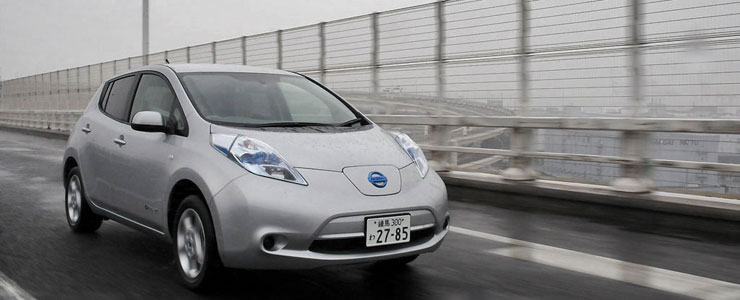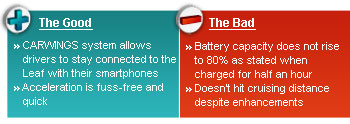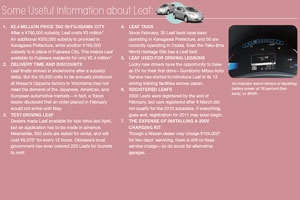Nissan Leaf EV Review
18 May 2011|12,637 views
Article Courtesy of  |
 |
As a pioneering electric vehicle (EV), Nissan Leaf raises many questions about its performance. We have chosen to focus on the five most pertinent ones. First, how far it can actually travel. Second, differences between traveling on normal roads and freeways, with the air-conditioning on and off. Third, length of time it takes to fully replenish Leaf's battery with a regular 200V charger. Fourth, acceleration and performance. And fifth, T-System's role in the operation of Leaf.
With these five criterions in mind, we downloaded Nissan Leaf's iPhone application, which allows users to check the battery's status and to control the air-conditioning system. Onscreen, the battery was indicated in red, and our first glance revealed a 172km travel distance. True enough, Leaf's dashboard meter displayed an identical reading.
First test: Electricity consumption on normal roads and freeways
Run 1: Freeway on "Drive" mode with 25°C air-conditioning
The Leaf's customisable start-up sound—with three different tones to choose from—immediately relaxes the driver, and provides a true EV ambience. Leaf's detailed meters will take at least half a day to memorise, but the abundant information that they provide make the endeavour worthwhile. For comparison's sake, we also drove Mitsubishi i MiEV, which reputedly travelled 1300km on a single full charge.
The fully-charged Leaf and i MiEV left Ikebukuro, and entered Tokyo's freeway on Drive mode with a 25°C cabin temperature. We passed Odaiba's coastline and were thoroughly enjoying the drive that we did not even notice that the battery level had fallen from 12 to nine "bars" until we were crossing the Rainbow Bridge! We were worried that the remaining 90km would not make it to Yokohama Landmark Tower's parking lot, but we arrived with 30km to spare.
With these five criterions in mind, we downloaded Nissan Leaf's iPhone application, which allows users to check the battery's status and to control the air-conditioning system. Onscreen, the battery was indicated in red, and our first glance revealed a 172km travel distance. True enough, Leaf's dashboard meter displayed an identical reading.
First test: Electricity consumption on normal roads and freeways
Run 1: Freeway on "Drive" mode with 25°C air-conditioning
The Leaf's customisable start-up sound—with three different tones to choose from—immediately relaxes the driver, and provides a true EV ambience. Leaf's detailed meters will take at least half a day to memorise, but the abundant information that they provide make the endeavour worthwhile. For comparison's sake, we also drove Mitsubishi i MiEV, which reputedly travelled 1300km on a single full charge.
The fully-charged Leaf and i MiEV left Ikebukuro, and entered Tokyo's freeway on Drive mode with a 25°C cabin temperature. We passed Odaiba's coastline and were thoroughly enjoying the drive that we did not even notice that the battery level had fallen from 12 to nine "bars" until we were crossing the Rainbow Bridge! We were worried that the remaining 90km would not make it to Yokohama Landmark Tower's parking lot, but we arrived with 30km to spare.
 |
50 minutes after leaving Ikebukuro, we arrived at Oguro Parking Area, where we examined the Leaf's and i MiEV's remaining charge. Leaf travelled 63.4km, and had five bars remaining, making its electronic consumption 4.6km/kWh.
On the other hand, a peek at i MiEV's analogue meter revealed that it travelled 62km and had two out of 16 bars left. With its fully charged 16kWh capacity considered, electricity consumption stood at 4.4km/kWh.
Vehicle weight and air drag coefficient influence an EV's electricity consumption, just as they do to the fuel consumption of a conventional car. Although both have lithium-ion batteries, Leaf weighed 1520kg to i MiEV's 1100kg. On the other hand, Leaf's 24kWh capacity stretched its cruising distance.
Despite the fact that both EVs accelerated smoothly and easily through traffic, Leaf won out in terms of power: it achieved 109bhp compared to i MiEV's 64bhp. Additionally, Leaf's 280Nm of torque was equivalent to that of a conventional 3.0-litre powerplant, while i MiEv's 180Nm of torque was comparable to a regular 2.0-litre car.
 |
Article Courtesy of  |
 |
Run 2: Normal roads without air-conditioning
For the return trip, we drove in normal traffic with the air-conditioning switched off. According to Nissan, the Leaf's "Eco" mode enhances acceleration, and that its regenerative braking system charges the battery while braking. This supposedly provides an additional 30 - 40km of cruising distance. But the test showed that Leaf did not reach the promised 200km cruising distance despite the enhancements.
(Note: if you really want to boost travel distance, try driving at lower speeds, which is the same principle behind improved fuel consumption in regular cars. While driving Leaf on freeways, switch to Eco mode and maintain speed at 80km/h or less. Gently press on the regenerative brakes, but do not exert too much pressure lest the mechanical brakes be engaged instead.)
We took a closer look at Leaf's dashboard meters. The battery's remaining power was displayed on the right, while recharging status was at its left. The speedometer was located above these, with the Eco indicator (symbolised by trees) beside it - the more "trees" are displayed, the more efficient the drive.
We parked the Leaf at Tomioka Hachimangu Shrine after traveling 54km at 7km/ kWh. Total cruising in Eco mode was already 168km. All five "trees" on the Eco indicator was shown and that should yield an additional 2km. On the other hand, i MiEV consumed 13 bars, which meant that it could only achieve 109km on a full charge. Therefore, Leaf still had the advantage.
For the return trip, we drove in normal traffic with the air-conditioning switched off. According to Nissan, the Leaf's "Eco" mode enhances acceleration, and that its regenerative braking system charges the battery while braking. This supposedly provides an additional 30 - 40km of cruising distance. But the test showed that Leaf did not reach the promised 200km cruising distance despite the enhancements.
(Note: if you really want to boost travel distance, try driving at lower speeds, which is the same principle behind improved fuel consumption in regular cars. While driving Leaf on freeways, switch to Eco mode and maintain speed at 80km/h or less. Gently press on the regenerative brakes, but do not exert too much pressure lest the mechanical brakes be engaged instead.)
We took a closer look at Leaf's dashboard meters. The battery's remaining power was displayed on the right, while recharging status was at its left. The speedometer was located above these, with the Eco indicator (symbolised by trees) beside it - the more "trees" are displayed, the more efficient the drive.
We parked the Leaf at Tomioka Hachimangu Shrine after traveling 54km at 7km/ kWh. Total cruising in Eco mode was already 168km. All five "trees" on the Eco indicator was shown and that should yield an additional 2km. On the other hand, i MiEV consumed 13 bars, which meant that it could only achieve 109km on a full charge. Therefore, Leaf still had the advantage.
Second test: Quick versus normal charging
Both Leaf and i MiEV's Quick Charging capabilities supposedly replenish 80 per cent of its battery power in 30 minutes. But are these claims true?
We charged the Leaf at a Nissan Quick Charge station, and found that its battery capacity had risen from 44 per cent to 89 per cent in half an hour. Actual recharge capabilities depend on ambient temperature and remaining battery level, as well as the settings at the charging facility (Nissan stations typically set their timers to 30 minutes, but others may configure theirs to almost an hour). In the Leaf's case, the battery-low warning activated when only two bars - equivalent to 30km - remained. A half-hour Quick Charge should fill up the car with 10 bars, while a normal 200V charger will fill the same amount in 60 - 80 minutes.
Leaf fully charges in eight hours on a regular 200V charger, and a single battery bar appears after 40 - 45 minutes. As aforementioned, actual recharging capabilities are again dependent on ambient temperature. Charging with only a 100V outlet can take up to 28 hours.
As part of Nissan's Zero-Emission Support Programme, every Leaf purchase qualifies the driver to free 200V Quick Charges at Nissan facilities for only ¥1,500 a month. Non-members are charged ¥525 per 30-minute regular charge, and ¥1,050 for every 60-minute charge. (In Shizuoka Prefecture, Nissan and Mitsubishi EVs can be charged for free!)
Both Leaf and i MiEV's Quick Charging capabilities supposedly replenish 80 per cent of its battery power in 30 minutes. But are these claims true?
We charged the Leaf at a Nissan Quick Charge station, and found that its battery capacity had risen from 44 per cent to 89 per cent in half an hour. Actual recharge capabilities depend on ambient temperature and remaining battery level, as well as the settings at the charging facility (Nissan stations typically set their timers to 30 minutes, but others may configure theirs to almost an hour). In the Leaf's case, the battery-low warning activated when only two bars - equivalent to 30km - remained. A half-hour Quick Charge should fill up the car with 10 bars, while a normal 200V charger will fill the same amount in 60 - 80 minutes.
Leaf fully charges in eight hours on a regular 200V charger, and a single battery bar appears after 40 - 45 minutes. As aforementioned, actual recharging capabilities are again dependent on ambient temperature. Charging with only a 100V outlet can take up to 28 hours.
As part of Nissan's Zero-Emission Support Programme, every Leaf purchase qualifies the driver to free 200V Quick Charges at Nissan facilities for only ¥1,500 a month. Non-members are charged ¥525 per 30-minute regular charge, and ¥1,050 for every 60-minute charge. (In Shizuoka Prefecture, Nissan and Mitsubishi EVs can be charged for free!)
 |
Article Courtesy of  |
 |
Third test: Acceleration
According to Leaf's published specifications, it accelerates from naught to hundred in 11.1 seconds. Although Prius still has the best acceleration time of10.4 seconds, the Leaf was comparable to a 2.0-litre gasoline engine such as the 2.0-litre X-Trail, which reaches 100km/h from standstill in 10.7 seconds.
Leaf did not rumble like conventional cars. Acceleration felt just like a ride on a descending rollercoaster - quick and fuss-free. However, the set-back of driving at such speeds is that battery depletes at a much faster rate.
The 4445mm x 1770mm x 1545mm Leaf's heavy battery increases its weight to 1520kg, 20kg heavier than the 2.0-litre X-Trail. The battery is situated in the middle of the chassis beneath the cabin floor, which results in slightly elevated rear seats. That said, the Leaf is just as comfortable as a Skyline saloon.
Fourth test: Availability of charging stations
An EV driver's most persistent worry is a rapidly depleting battery. Unlike gasoline stations, which are found in abundance, electric charging facilities are few and far in between. Nissan's solution is the CARWINGS system, found in Leaf's G and X variants. CARWINGS enables drivers to stay connected to Leaf via their smart phones. Even better, it updates the navigation system with the route information of the nearest Nissan charging station. This innovative feature is available 24-hours a day. Alternative operators provide a similar service, where the nearest charging station can be contacted at the push of a button.
According to Leaf's published specifications, it accelerates from naught to hundred in 11.1 seconds. Although Prius still has the best acceleration time of10.4 seconds, the Leaf was comparable to a 2.0-litre gasoline engine such as the 2.0-litre X-Trail, which reaches 100km/h from standstill in 10.7 seconds.
Leaf did not rumble like conventional cars. Acceleration felt just like a ride on a descending rollercoaster - quick and fuss-free. However, the set-back of driving at such speeds is that battery depletes at a much faster rate.
The 4445mm x 1770mm x 1545mm Leaf's heavy battery increases its weight to 1520kg, 20kg heavier than the 2.0-litre X-Trail. The battery is situated in the middle of the chassis beneath the cabin floor, which results in slightly elevated rear seats. That said, the Leaf is just as comfortable as a Skyline saloon.
Fourth test: Availability of charging stations
An EV driver's most persistent worry is a rapidly depleting battery. Unlike gasoline stations, which are found in abundance, electric charging facilities are few and far in between. Nissan's solution is the CARWINGS system, found in Leaf's G and X variants. CARWINGS enables drivers to stay connected to Leaf via their smart phones. Even better, it updates the navigation system with the route information of the nearest Nissan charging station. This innovative feature is available 24-hours a day. Alternative operators provide a similar service, where the nearest charging station can be contacted at the push of a button.
During the test drive, we discovered that charging facilities are gradually becoming readily accessible. While gasoline stations are still the standard fare, charging stations have appeared in places like the Yokohama Landmark Tower, the Shin-Marunouchi Building in Tokyo, and the Cerulean Building in Shibuya - even convenience stores like FamilyMart and Lawson has them!
Ultimate goal: To maximise electricity consumption
Word on the street is that car lovers will not enjoy driving EVs, but Leaf may shift the balance. Over the two days (and 305km) that we drove it, we had to take eight short recharge breaks. Although Leaf requires more upkeep, it was definitely a joy to handle. Nissan has improved electric consumption, enabling longer cruising distances. Even the casual driver will appreciate the experience of driving Leaf.
What do you think? Jot down your opinions at the comment box below.
Ultimate goal: To maximise electricity consumption
Word on the street is that car lovers will not enjoy driving EVs, but Leaf may shift the balance. Over the two days (and 305km) that we drove it, we had to take eight short recharge breaks. Although Leaf requires more upkeep, it was definitely a joy to handle. Nissan has improved electric consumption, enabling longer cruising distances. Even the casual driver will appreciate the experience of driving Leaf.
 |
What do you think? Jot down your opinions at the comment box below.
 |
Article Courtesy of  |
 |
As a pioneering electric vehicle (EV), Nissan Leaf raises many questions about its performance. We have chosen to focus on the five most pertinent ones. First, how far it can actually travel. Second, differences between traveling on normal roads and freeways, with the air-conditioning on and off. Third, length of time it takes to fully replenish Leaf's battery with a regular 200V charger. Fourth, acceleration and performance. And fifth, T-System's role in the operation of Leaf.
With these five criterions in mind, we downloaded Nissan Leaf's iPhone application, which allows users to check the battery's status and to control the air-conditioning system. Onscreen, the battery was indicated in red, and our first glance revealed a 172km travel distance. True enough, Leaf's dashboard meter displayed an identical reading.
First test: Electricity consumption on normal roads and freeways
Run 1: Freeway on "Drive" mode with 25°C air-conditioning
The Leaf's customisable start-up sound—with three different tones to choose from—immediately relaxes the driver, and provides a true EV ambience. Leaf's detailed meters will take at least half a day to memorise, but the abundant information that they provide make the endeavour worthwhile. For comparison's sake, we also drove Mitsubishi i MiEV, which reputedly travelled 1300km on a single full charge.
The fully-charged Leaf and i MiEV left Ikebukuro, and entered Tokyo's freeway on Drive mode with a 25°C cabin temperature. We passed Odaiba's coastline and were thoroughly enjoying the drive that we did not even notice that the battery level had fallen from 12 to nine "bars" until we were crossing the Rainbow Bridge! We were worried that the remaining 90km would not make it to Yokohama Landmark Tower's parking lot, but we arrived with 30km to spare.
With these five criterions in mind, we downloaded Nissan Leaf's iPhone application, which allows users to check the battery's status and to control the air-conditioning system. Onscreen, the battery was indicated in red, and our first glance revealed a 172km travel distance. True enough, Leaf's dashboard meter displayed an identical reading.
First test: Electricity consumption on normal roads and freeways
Run 1: Freeway on "Drive" mode with 25°C air-conditioning
The Leaf's customisable start-up sound—with three different tones to choose from—immediately relaxes the driver, and provides a true EV ambience. Leaf's detailed meters will take at least half a day to memorise, but the abundant information that they provide make the endeavour worthwhile. For comparison's sake, we also drove Mitsubishi i MiEV, which reputedly travelled 1300km on a single full charge.
The fully-charged Leaf and i MiEV left Ikebukuro, and entered Tokyo's freeway on Drive mode with a 25°C cabin temperature. We passed Odaiba's coastline and were thoroughly enjoying the drive that we did not even notice that the battery level had fallen from 12 to nine "bars" until we were crossing the Rainbow Bridge! We were worried that the remaining 90km would not make it to Yokohama Landmark Tower's parking lot, but we arrived with 30km to spare.
 |
50 minutes after leaving Ikebukuro, we arrived at Oguro Parking Area, where we examined the Leaf's and i MiEV's remaining charge. Leaf travelled 63.4km, and had five bars remaining, making its electronic consumption 4.6km/kWh.
On the other hand, a peek at i MiEV's analogue meter revealed that it travelled 62km and had two out of 16 bars left. With its fully charged 16kWh capacity considered, electricity consumption stood at 4.4km/kWh.
Vehicle weight and air drag coefficient influence an EV's electricity consumption, just as they do to the fuel consumption of a conventional car. Although both have lithium-ion batteries, Leaf weighed 1520kg to i MiEV's 1100kg. On the other hand, Leaf's 24kWh capacity stretched its cruising distance.
Despite the fact that both EVs accelerated smoothly and easily through traffic, Leaf won out in terms of power: it achieved 109bhp compared to i MiEV's 64bhp. Additionally, Leaf's 280Nm of torque was equivalent to that of a conventional 3.0-litre powerplant, while i MiEv's 180Nm of torque was comparable to a regular 2.0-litre car.
 |
Article Courtesy of  |
 |
Run 2: Normal roads without air-conditioning
For the return trip, we drove in normal traffic with the air-conditioning switched off. According to Nissan, the Leaf's "Eco" mode enhances acceleration, and that its regenerative braking system charges the battery while braking. This supposedly provides an additional 30 - 40km of cruising distance. But the test showed that Leaf did not reach the promised 200km cruising distance despite the enhancements.
(Note: if you really want to boost travel distance, try driving at lower speeds, which is the same principle behind improved fuel consumption in regular cars. While driving Leaf on freeways, switch to Eco mode and maintain speed at 80km/h or less. Gently press on the regenerative brakes, but do not exert too much pressure lest the mechanical brakes be engaged instead.)
We took a closer look at Leaf's dashboard meters. The battery's remaining power was displayed on the right, while recharging status was at its left. The speedometer was located above these, with the Eco indicator (symbolised by trees) beside it - the more "trees" are displayed, the more efficient the drive.
We parked the Leaf at Tomioka Hachimangu Shrine after traveling 54km at 7km/ kWh. Total cruising in Eco mode was already 168km. All five "trees" on the Eco indicator was shown and that should yield an additional 2km. On the other hand, i MiEV consumed 13 bars, which meant that it could only achieve 109km on a full charge. Therefore, Leaf still had the advantage.
For the return trip, we drove in normal traffic with the air-conditioning switched off. According to Nissan, the Leaf's "Eco" mode enhances acceleration, and that its regenerative braking system charges the battery while braking. This supposedly provides an additional 30 - 40km of cruising distance. But the test showed that Leaf did not reach the promised 200km cruising distance despite the enhancements.
(Note: if you really want to boost travel distance, try driving at lower speeds, which is the same principle behind improved fuel consumption in regular cars. While driving Leaf on freeways, switch to Eco mode and maintain speed at 80km/h or less. Gently press on the regenerative brakes, but do not exert too much pressure lest the mechanical brakes be engaged instead.)
We took a closer look at Leaf's dashboard meters. The battery's remaining power was displayed on the right, while recharging status was at its left. The speedometer was located above these, with the Eco indicator (symbolised by trees) beside it - the more "trees" are displayed, the more efficient the drive.
We parked the Leaf at Tomioka Hachimangu Shrine after traveling 54km at 7km/ kWh. Total cruising in Eco mode was already 168km. All five "trees" on the Eco indicator was shown and that should yield an additional 2km. On the other hand, i MiEV consumed 13 bars, which meant that it could only achieve 109km on a full charge. Therefore, Leaf still had the advantage.
Second test: Quick versus normal charging
Both Leaf and i MiEV's Quick Charging capabilities supposedly replenish 80 per cent of its battery power in 30 minutes. But are these claims true?
We charged the Leaf at a Nissan Quick Charge station, and found that its battery capacity had risen from 44 per cent to 89 per cent in half an hour. Actual recharge capabilities depend on ambient temperature and remaining battery level, as well as the settings at the charging facility (Nissan stations typically set their timers to 30 minutes, but others may configure theirs to almost an hour). In the Leaf's case, the battery-low warning activated when only two bars - equivalent to 30km - remained. A half-hour Quick Charge should fill up the car with 10 bars, while a normal 200V charger will fill the same amount in 60 - 80 minutes.
Leaf fully charges in eight hours on a regular 200V charger, and a single battery bar appears after 40 - 45 minutes. As aforementioned, actual recharging capabilities are again dependent on ambient temperature. Charging with only a 100V outlet can take up to 28 hours.
As part of Nissan's Zero-Emission Support Programme, every Leaf purchase qualifies the driver to free 200V Quick Charges at Nissan facilities for only ¥1,500 a month. Non-members are charged ¥525 per 30-minute regular charge, and ¥1,050 for every 60-minute charge. (In Shizuoka Prefecture, Nissan and Mitsubishi EVs can be charged for free!)
Both Leaf and i MiEV's Quick Charging capabilities supposedly replenish 80 per cent of its battery power in 30 minutes. But are these claims true?
We charged the Leaf at a Nissan Quick Charge station, and found that its battery capacity had risen from 44 per cent to 89 per cent in half an hour. Actual recharge capabilities depend on ambient temperature and remaining battery level, as well as the settings at the charging facility (Nissan stations typically set their timers to 30 minutes, but others may configure theirs to almost an hour). In the Leaf's case, the battery-low warning activated when only two bars - equivalent to 30km - remained. A half-hour Quick Charge should fill up the car with 10 bars, while a normal 200V charger will fill the same amount in 60 - 80 minutes.
Leaf fully charges in eight hours on a regular 200V charger, and a single battery bar appears after 40 - 45 minutes. As aforementioned, actual recharging capabilities are again dependent on ambient temperature. Charging with only a 100V outlet can take up to 28 hours.
As part of Nissan's Zero-Emission Support Programme, every Leaf purchase qualifies the driver to free 200V Quick Charges at Nissan facilities for only ¥1,500 a month. Non-members are charged ¥525 per 30-minute regular charge, and ¥1,050 for every 60-minute charge. (In Shizuoka Prefecture, Nissan and Mitsubishi EVs can be charged for free!)
 |
Article Courtesy of  |
 |
Third test: Acceleration
According to Leaf's published specifications, it accelerates from naught to hundred in 11.1 seconds. Although Prius still has the best acceleration time of10.4 seconds, the Leaf was comparable to a 2.0-litre gasoline engine such as the 2.0-litre X-Trail, which reaches 100km/h from standstill in 10.7 seconds.
Leaf did not rumble like conventional cars. Acceleration felt just like a ride on a descending rollercoaster - quick and fuss-free. However, the set-back of driving at such speeds is that battery depletes at a much faster rate.
The 4445mm x 1770mm x 1545mm Leaf's heavy battery increases its weight to 1520kg, 20kg heavier than the 2.0-litre X-Trail. The battery is situated in the middle of the chassis beneath the cabin floor, which results in slightly elevated rear seats. That said, the Leaf is just as comfortable as a Skyline saloon.
Fourth test: Availability of charging stations
An EV driver's most persistent worry is a rapidly depleting battery. Unlike gasoline stations, which are found in abundance, electric charging facilities are few and far in between. Nissan's solution is the CARWINGS system, found in Leaf's G and X variants. CARWINGS enables drivers to stay connected to Leaf via their smart phones. Even better, it updates the navigation system with the route information of the nearest Nissan charging station. This innovative feature is available 24-hours a day. Alternative operators provide a similar service, where the nearest charging station can be contacted at the push of a button.
According to Leaf's published specifications, it accelerates from naught to hundred in 11.1 seconds. Although Prius still has the best acceleration time of10.4 seconds, the Leaf was comparable to a 2.0-litre gasoline engine such as the 2.0-litre X-Trail, which reaches 100km/h from standstill in 10.7 seconds.
Leaf did not rumble like conventional cars. Acceleration felt just like a ride on a descending rollercoaster - quick and fuss-free. However, the set-back of driving at such speeds is that battery depletes at a much faster rate.
The 4445mm x 1770mm x 1545mm Leaf's heavy battery increases its weight to 1520kg, 20kg heavier than the 2.0-litre X-Trail. The battery is situated in the middle of the chassis beneath the cabin floor, which results in slightly elevated rear seats. That said, the Leaf is just as comfortable as a Skyline saloon.
Fourth test: Availability of charging stations
An EV driver's most persistent worry is a rapidly depleting battery. Unlike gasoline stations, which are found in abundance, electric charging facilities are few and far in between. Nissan's solution is the CARWINGS system, found in Leaf's G and X variants. CARWINGS enables drivers to stay connected to Leaf via their smart phones. Even better, it updates the navigation system with the route information of the nearest Nissan charging station. This innovative feature is available 24-hours a day. Alternative operators provide a similar service, where the nearest charging station can be contacted at the push of a button.
During the test drive, we discovered that charging facilities are gradually becoming readily accessible. While gasoline stations are still the standard fare, charging stations have appeared in places like the Yokohama Landmark Tower, the Shin-Marunouchi Building in Tokyo, and the Cerulean Building in Shibuya - even convenience stores like FamilyMart and Lawson has them!
Ultimate goal: To maximise electricity consumption
Word on the street is that car lovers will not enjoy driving EVs, but Leaf may shift the balance. Over the two days (and 305km) that we drove it, we had to take eight short recharge breaks. Although Leaf requires more upkeep, it was definitely a joy to handle. Nissan has improved electric consumption, enabling longer cruising distances. Even the casual driver will appreciate the experience of driving Leaf.
What do you think? Jot down your opinions at the comment box below.
Ultimate goal: To maximise electricity consumption
Word on the street is that car lovers will not enjoy driving EVs, but Leaf may shift the balance. Over the two days (and 305km) that we drove it, we had to take eight short recharge breaks. Although Leaf requires more upkeep, it was definitely a joy to handle. Nissan has improved electric consumption, enabling longer cruising distances. Even the casual driver will appreciate the experience of driving Leaf.
 |
What do you think? Jot down your opinions at the comment box below.
 |
Thank You For Your Subscription.



































